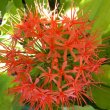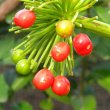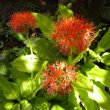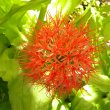| Botanical Name |
Scadoxus multiflorus subsp. Katherinae |
| Family |
Amaryllidaceae - The amaryllis family. |
| Pronunciation |
ska-DOKS-us mul-tih-FLOR-us subsp. KATH-er-in-ay |
| Common Name(s) |
English: Blood flower; Catherine wheel; Poison root; Fireball lily
Afrikaans: Bloedblom; Gifwortel
IsiZulu: Idunjana; Ubukhoswane
|
| Plant Group |
- Bulb / Corm / Rhizome / Tuber / Epigeal bulb Bulbs: are made up of fleshy scales as in an onion
Corm: a short, swollen, underground stem that is hard and not fleshy as in a gladiolus
Tuber: a solid, fleshy, underground, storage organ as in a potato
Rhizome: an underground, horizontal, swollen stem at the base of the plant as in an iris
Epigeal bulb: bulbs that rest above the ground with only the roots anchoring the plant to the earth as in albuca
|
| Plant Size |
- Large
| Tree | 18m to 25m |
| Shrub | 3m to 4m |
| Perennial/ground cover | 75cm to 1m |
| Bulb | 80cm to 1.2m |
| Succulent | 1m to 1.5m |
|
| Position |
- Canopy Shade Canopy shade is found below closely grown trees where some light filters through. Ideal for the protection of herbaceous plants.
- Deep / Full Shade Shade below spreading evergreen trees where sun's rays are unable to penetrate the canopy at any time. For light sensitive plants
- Light or Dappled Shade Found below trees with sparse, open foliage. Ideal for the protection of herbaceous plants.
|
| General Information |
- Attractive fruits, berries or seeds Brightly coloured fruits or berries increase and extend the visual impact of the plant and are especially attractive to birds and other small wildlife.
- Drought Tolerance: High The plant is well adapted to arid conditions; it can survive long periods of drought and high temperatures without extra water.
- Evergreen to semi-deciduous The plant is evergreen in warmer, wetter parts of the country, but may lose some of its leaves during winter in colder, drier situations.
- Frost: Tender A plant that will not survive any frost or low winter temperatures.
- Water Loving Plants need a regular supply of water and must not be allowed to dry out for any length of time.
|
| Specific Information |
The bright, green leaves of Scadoxus multiflorus subsp. Katherinae are large and thinly-textured, with a wavy margin. They are arranged around the center of the plant, creating a pleasing rosette. According to some sources, Scadoxus may be deciduous in winter in colder climates. Although we have reasonably mild winters in Bathurst, I have noticed that it is cold enough for both Scadoxus and Haemanthus to go completely dormant in winter.
The genus Scadoxus are generally considered strongly toxic plants and should not be eaten by humans or animals.
|
| Ad Break |
|
| Flowers |
| Description |
a large rounded head up to 25 cm across, made up of scores of individual tubular flowers with narrow petals, held above the leaves on a thick pseudo-stem.
|
| Season |
- Summer to Autumn Plants will seldom bloom for the entire season as given in the list, but should flower during a period within these parameters.
|
| Colour |
|
| Growth Rate |
- Moderate Specifying growth rate can be very misleading as there is considerable variation of growth rate depending on type and species of plant, available water, supplementary feeding, mulching and general care, as well as the plants suitability and adaptability to the garden environment.
|
| Plant Uses |
- Accent or Focal Point A plant used to attract the attention because of its colour or form.
- Attracts bees, butterflies or other insects This plant attracts insects which can be food for birds or other creatures in your garden.
- Attracts Birds This plant will attract birds.
- Border A strip of ground, at the edge of a driveway or path in which ornamental plants or shrubs are planted.
- Boundary A plant useful for planting around the edges of the property to form a green or colourful backdrop, an impenetrable hedge, to hide walls or create privacy.
- Container Trees, shrubs and ornamental species that can adapt to growing in a restricted environment.
- Cut Flowers Plants that provide flowers suitable for ornamental uses.
- Filler Either a fast growing tree or shrub used temporarily to fill in an area while the permanent plants grow to a desired size, or a plant used to fill gaps in borders or beds.
- Pot Plant A plant that needs a protected environment on a patio or indoors.
- Wild Garden An indigenous garden planted for the benefit of wildlife and birds. Provides food, water, a variety of mini-biomes and no poisonous chemicals are used.
|
| Distribution and Habitat |
from the Eastern Cape, to KwaZulu-Natal and Mpumalanga, as well as Swaziland, Mozambique and Zimbabwe, in forests and along forest margins, in woodlands and grasslands and under trees at river banks
|
| Planting Suggestions |
Scadoxus are planted just below the ground and should be left undisturbed for many years. Plant in well-drained, rich soil, with plenty of leaf-mould or well-rotted compost. Scadoxus like plenty of water in spring and summer when in active growth, but must not be watered during the dormant period. It will survive the wet winters of the Western Cape, provided it is very well-drained. For optimum healthy growth, feed occasionally with a liquid fertiliser.
|
| Medicinal Uses |
In conjunction with a number of other plants, Scadoxus multiflorus and Scadoxus cinnabarinus have been used in the northern areas of their distribution as both arrow and fish poisons. The bulb is used medicinally to treat dropsy, scabies and poorly healing wounds. They are known to be lethal to stock.
|
| Ad Break |
|








Comments
Scadoxus Punicious & S Multiflorus
My S. punicious has bloomed every year since 2005.However not in 2011.Had good seeds in 2005 and 8 grew very well.They are all planted in a group (advice from Pitta Joffe)and afforded a lot pleasure although the seedlings have not bloomed at all until 2011 and the blooms are S Multiflorus!!! Rather pathetic too. 3 in total.These are plante in a patch in my clivias. The S Multiflorus are in a container on rhe other side of the house, shady area well protected fromk the cold. They had pathetic blooms this month that appeared well after the leaves which seemed to be very scraggly. Both species seem to need I wish I knew what because I would love to have them behave as they did to start with 5 years ago. PLEASE can you advise, help, suggest something I can do? They are such special plants.
Kind Regards,
Rosemary Fourie
Scadoxus - poor performance
Hi Rosemary
Thanks to your query I have learnt a whole lot more about Scadoxus than I knew before.
Many thanks to my bulb guru, Rob (rob@shire.co.za) for the information he provided. It seems all is not lost.
First the mystery S. puniceus plants with multiflorus flowers: the most likely scenario is that the two species cross-pollinated. You may find that the flowers will not perform any better than they have done this season because they are 'genetically confused'.
Now the S. puniceus that did not flower: Although in some years prevailing climatic conditions do result in poor flowering, it is more likely that your plants have used up the nutrients in the soil and were thus unable to flower. Scadoxus are very greedy feeders and will leach the ground of nutrients unless these are regularly replaced. Feed them with a slow release organic fertiliser, top dress them with a layer of compost and cover with a good layer of organic mulch (see blog: Lazy Gardening for the Future: Much More Mulch). Ensure that they have a dry, dormant period through winter.
The S. multiflorus that have been in the container for 5 years have probably become pot bound and crowded, and are starving for nutrients. Once they have gone dormant, remove them, separate and re-pot in a very rich potting mixture with plenty of organic compost. They should be re-potted every 3 years and be fed at regular intervals. A liquid feed would probably be the simplest.
I wouldn't worry about the leaves forming before the flowers, as all the Scadoxus I have seen in our part of the Eastern Cape, get their leaves before flowering.
It is interesting to note that the wild Scadoxus in this area only flower every three to four years, presumably storing up nutrients until they are sufficiently strong enough to produce a flower. If we want them to flower every year it makes sense that they will need more feeding than they get in nature.
Do let us know what happens next season. Before and after pictures would also be most welcome and informative for other readers.
scadoxis katherinae
I have just been given a scaodoxis. Do they prefer sun or shade??
Scadoxus planting position
Hi Bella
Scadoxus grow best in canopy shade, deep or full shade and light or dappled shade. Before you plant out your bulb, it may be a good idea to re-read the information contained in the plant page above so that you plant it in the best possible position.
Kind regards
Lorraine
Distribution of Scadoxus
Hi Lorraine
I am a Botanist student and I would like to know the destribution of the S. multiflorus in the province of the Eastern Cape, South Africa.
Distribution of Scadoxus multiflorus in the Eastern Cape
Hi Tile
As I did for your query about Brunsvigia, I have referred you to the distribution map for this plant on the Threatened Species Programme. Using this map and a map of the Eastern Cape, you will be able to pinpoint the areas in which this species grows in the province.
Go to: http://redlist.sanbi.org/species.php?species=2089-3
Best of luck with your studies.
Kind regards
Lorraine
Scadoxus
I am most unhappy with our Scadoxus. They sprout well enough but hardsly ever bloom. We have the punicious and multiflora in the garden. Recently in the Kruger Park they seemed more or less ignored and neglected and were beautiful. I have tried them in pots and that was a disaster.This is the last time I am goi8ng to replant them but please tell me HOW! Kind regards, Rosemary
Transplanting Scadoxus
Hi Rosemary
Many thanks for your question.
You are not the only one who has asked for guidance with this issue, so I decided to answer your question on my blog. Go to:
http://kumbulanursery.co.za/blog/transplanting-my-scadoxus
I hope this will be helpful.
Regards
Lorraine
Scadoxus multiflorus subsp. Katherinae growing in water
A number of years ago I collected a few seeds of Scadoxus multiflorus subsp. Katherinae in a swamp forest on the Natal south coast which I planted inside my house in small pots containing expanded clay pellets which I stood in large shallow dishes filled with water. As they outgrew their pots they were planted into bigger pots but always kept in water. I feed them on a regular basis with soluble fertiliser. These plants which stand in water year round have now grown into huge healthy specimens that flower profusely. I have added a photo of the first flowering, I must get around to take photos of the now mature plants when the current buds open
You can grow them in water?!
Hi Michael
Thanks for your comment. What an interesting way to grow them. You have really brought home to me the reason mine did not thrive - they simply did not get enough water. That was before the trusty Mole Rats ate the bulbs, of course. In the area where I live, the soil is very poor and limy, and water is always scarce - hardly the best situation for a food and water greedy bulb like this.
I would love some photos of the mature plants. I am waiting in anticipation to hear from you again.
Kind regards
Lorraine
Scadoxus multiflorus subsp. Katherinae
I grow my Scadoxus multiflorus subsp. Katherinae in a pot its in the shade. It always flowers & I fill the pot with aged pig manure & chook manure. They grow huge here waist height. I'm in Bendigo victoria, Australia. Out weather can fluctuate from -8 deg to 49 deg.
Scadoxus multiflorus subsp. Katherinae
More photos
Discuss this plant
Share knowledge, ask a question or give an experience.